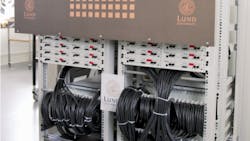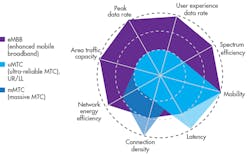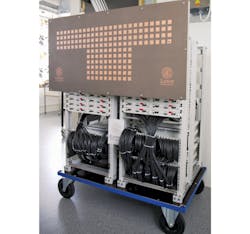Making Waves: The Road to Enhanced Mobile Broadband
This file type includes high-resolution graphics and schematics when applicable.
Ed. note: Electronic Design would like to welcome Charles Schroeder, VP RF and Wireless, National Instruments, as a new guest columnist.
You might remember getting your first e-mail on a mobile device, and the frustration when an attachment was too big to download. Today, your smartphone downloads the largest attachments in seconds and streams video in high definition. Tomorrow, our mobile phones will consume even more data by an order of magnitude.
For example, a recent Cisco forecast predicts that by 2020, our networks will support 30.6 exabytes of mobile data traffic per month—nearly 10 times our current consumption. Not surprisingly, these requirements play a significant factor into the definition of 5G.
According to the ITU’s IMT 2020 Vision, the need to deliver enhanced mobile broadband (eMBB) is one of three distinct 5G use cases (Fig. 1). In this vision, eMBB is a natural evolution to the data rates we enjoy today with LTE and will enjoy tomorrow with LTE-A Pro. The ultimate 5G target is to deliver up to 10-Gb/s peak throughput, 1-Gb/s throughput in high mobility, and up to 10,000X total network traffic. Although this target might seem outrageous, it’s more attainable than you might think. In fact, technologies in development today, such as millimeter waves and massive MIMO, will play a critical role in achieving the eMBB goals.
Although eMBB is a critical part of 5G mobile communications, it’s not the only way that wireless standards are evolving. In fact, the ITU has also outlined two additional use cases, ultra-reliability Machine Type Communication (uMTC) and massive Machine Type Communication (mMTC). Designed to facilitate communication between “things” instead of people, these use cases have different requirements than eMBB. We will not discuss uMTC and mMTC requirements in detail in this article, but you can learn more about each of the three 5G use cases by checking out “Things Want a Different Internet Than You Do.”
New Bands for Mobile Communication
As our mobile networks evolved from GSM to UMTS to LTE, throughput improved through higher-order modulation schemes (like 64-QAM), wider bandwidths (often through carrier aggregation), and more spatial streams (8x8 MIMO in LTE Advanced). However, existing cellular and Wi-Fi bands don’t have sufficient bandwidth to deliver the aspirations of enhanced mobile broadband, so millimeter waves become the likely the solution (Fig. 2).
It has been more than a hundred years since Sir Jagadish Chandra “JC” Bose demonstrated some of the first millimeter-wave transmissions at 60 GHz.1 However, for more than a century, many engineers have remained skeptical about the viability of millimeter-wave (30 to 300 GHz) signals for mobile applications. This skepticism is so great that the title of a recent article in IEEE Access by world-renowned propagation expert Dr. Ted Rappaport was simply entitled “Millimeter Wave Mobile Communications for 5G Cellular: It Will Work!”
As we speak, researchers like Dr. Rappaport and others are in the midst of proving the viability of millimeter waves for commercial mobile applications—and they’re using radio prototyping tools to do it. For example, NI and Nokia collaborated to demonstrate the one of the world’s first 10-Gb/s transmission at 73 GHz back in 2015.2 Check out the video below:
The prototype used a combination of NI’s software-defined-radio (SDR) technology, and implemented the 5G PHY and MAC layers using multiple FPGAs. This year, at Mobile World Congress 2016 in Barcelona, NI and Nokia pushed the demonstration to 14.7 Gb/s by employing the 64-QAM modulation scheme.
Expanding Total Network Capacity
In addition to peak throughput, another key aspect of eMBB is total network capacity. Common targets for 5G include 10,000X total network traffic and the ability to to deliver 10-Tb/s per square kilometer. Achieving these goals requires improved spectral efficiency and is a major driver of the need for massive MIMO technology.
MIMO allows a communications system to use spectrum more efficiently by employing spatial multiplexing and beamforming. With spatial multiplexing, a base station uses multiple transmit antennas to beam distinct streams of information to multiple users at the same time using the same spectrum. Although MIMO technology is not new—and standards such as HSPA+ and LTE already use MIMO—these standards only allow for the use of a handful of transmit and receive antennas.
Today, 5G researchers are looking to massively increase the number of spatial streams used in a mobile communications system. For example, at NIWeek 2015, Dr. Farooq Khan, President of Samsung Research, and Gary Xu, Director of R&D, showed data-throughput improvements in multi-user scenarios with a with a full dimensional MIMO demonstration. Check out the video below:
The Samsung prototype used up to 32 transmit antennas, and was able to increase throughput to each individual user by about 10X using the same amount of spectrum.
Looking forward to 5G, researchers are prototyping MIMO systems with an increasing number of antennas. In fact the “massive” in “massive MIMO” could imply hundreds of antennas. Here at NI, we have been pleased to collaborate with leading researchers ranging from Lund University to NTT Docomo to help design some of the world’s most sophisticated massive MIMO prototypes.
Figure 3 illustrates a massive MIMO prototype in which each channel must be synchronized and carefully aggregated into a central FPGA. In fact, the system in Figure 2 utilizes more than FPGAs to process nearly 20 Gb/s of data spread across 100 RF channels in real-time.3
Innovations in Signal Processing
There’s no question that the evolution of our cellular network to support eMBB will usher in an era of new and exciting wireless technologies like millimeter wave and massive MIMO. Just as this evolution has implications on the radio and antenna in our mobile devices, it also has implications on the tools used by engineers to prototype tomorrow’s 5G.
Especially with eMBB, 5G prototyping is pushing the limits of what’s possible with commercial SDR technology. Whether a prototype is designed to demodulate 2 GHz of RF bandwidth in real time or aggregate 100 radio channels, 5G prototyping requires intense signal processing. The need for low latency combined with high algorithm complexity has driven intense adoption of FPGAs for these applications.
Not only is 5G prototyping providing our industry with a clearer picture of tomorrow’s mobile networks, it’s also driving innovation in FPGA programming tools. Here at NI, we’re excited to be a part of this revolution and are committed to continue to evolve our LabVIEW software as we tackle some of tomorrow’s most difficult FPGA programming challenges.
References
1. Darrel T. Emerson, “The Work of Jagadis Chandra Bose: 100 Years of Millimeter-Wave Research,” IEEE Transactions on Microwave Theory and Techniques, Vol. 45, No. 12, pp. 2267-2273, Dec. 1997.
2. Nokia Press Release: Nokia Networks showcases 5G speed of 10Gbps with NI at the Brooklyn 5G Summit.
3. Vieira, J.; Malkowsky, S.; Nieman, K.; Miers, Z.; Kundargi, N.; Liang Liu; Wong, I.; Owall, V.; Edfors, O.; Tufvesson, F., "A flexible 100-antenna testbed for Massive MIMO," in Globecom Workshops (GC Wkshps), 2014 , vol., no., pp.287-293, 8-12 Dec. 2014.
About the Author
Charles Schroeder
Vice President of Product Marketing, RF and Wireless Communications
As Vice President of Product Marketing for RF and Wireless Communications, Charles leads the global team responsible for product management, product marketing, and application segments of National Instruments's RF and wireless communications business.
Since joining NI in 1995, he has held various leadership roles across the IMAQ, DAQ, modular instruments, and RF product lines and is recognized for his excellent communication and presentation skills as witnessed by his regular presence on the NIWeek stage.
Schroeder holds a bachelor’s and master’s degree in electrical engineering from Texas A&M University.





